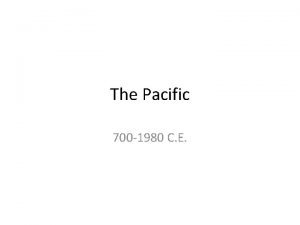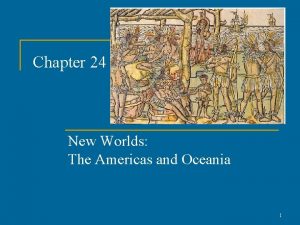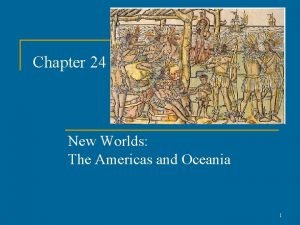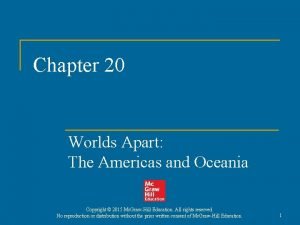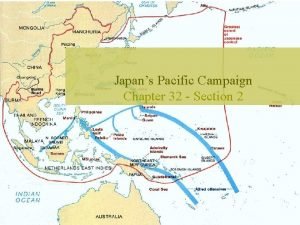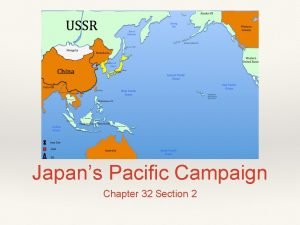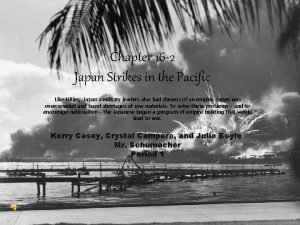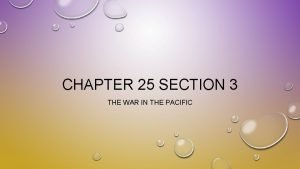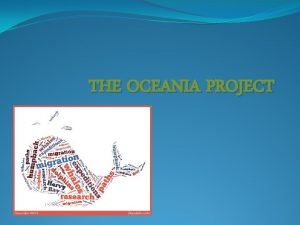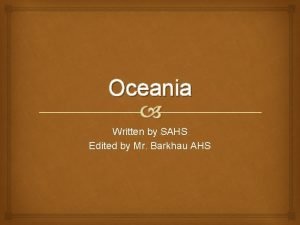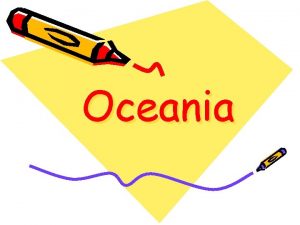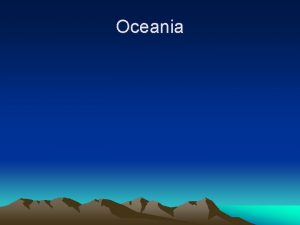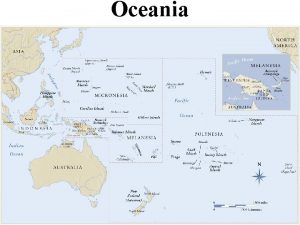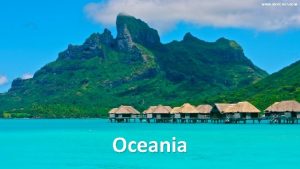Chapter 32 Pacific Oceania Art 1 Oceania 2










- Slides: 10

Chapter 32 Pacific /Oceania Art 1

Oceania 2

Asmat Art • Asmat people of New Guinea believed the universe was composed of powerful invisible forces or spirits that could not be controlled and should be honored, celebrated and contacted. • Asmat artists made masks an totems for one single use during great ceremonial celebrations • Wood was the favorite carving material which was originally carved with shells or animal teeth. After contact with European countries metal became available. • The masks were adorned with facial features and elaborate costumes used for ceremonial garments and weapons. 3

Asmat bisj poles, Buepis village, Fajit River, Casuarina Coast, Irian Jaya, Melanesia, early to mid-20 th century. The bisj poles, some more than 12 meters high, are made by the Asmat people from the Indonesian province of Papua (the former Dutch New Guinea). They are used during Bisj ceremonies, which are held to commemorate deceased members of the community. Each pole has its own powers of expression and symbolism, and every sculpture mirrors the world view of the Asmat. Cut from mangrove trees and layered with figures one atop the other which represent the dead. Asmat believed that death was unnatural and caused by an enemy through evil spells. Mangrove trees were symbolically hunted and cut down in a reenactment of the headhunt. Poles would be erected before a man’s house and mock a battle between men and women took place. 4

Easter Island • One of the most isolated places on earth. No counterparts in Pacific art to the great statues on Easter Island the nearest civilization that could have produced these large statues is South America. • About 900 statues total – mostly male almost all facing inland. • Each weighs about 50 tons • Erected on large platforms of stone mixed with ashes from ceremonies • Images represent personalities deified after death or commemorated as the first settler kings • Prominent foreheads, large broad noses, thin lips, ears that reach the top of the heads and thin arms falling straight down 5

Row of moai on a stone platform, Rapa Nui (Easter Island), Polynesia, 10 th to 12 th centuries. Volcanic tuff and red scoria. 6

Maori Art • New Zealand culture including the Native Maori people carry on a rich Polynesian tradition of wood carving, which is indigenous to people throughout the Pacific. • The Maori specialty is tattooing – often covering their entire body with spiral designs to signify rank or status. – Both men and women were tattoo artists and would work on commission – Tool set contained numerous bone chisels which would create a deep gouge in the flesh and then filled with pigment. – Men begin getting tattooed at puberty always accompanied with ceremonies and rituals – Women were tattooed for beautification purposes only – Persons with no tattoos were thought to have no social 7

Tattooed warrior with war club, Nukahiva, Marquesas Islands, Polynesia, early 19 th century. Color engraving in Carl Bertuch, Bilderbuch für Kinder (Weimar, 1813). 8

WEPIHA APANUI, Mataatua meetinghouse (view of interior), Maori, Whakatane, New Zealand, Polynesia, 1871 -1875. Maori meetinghouses are thought of as symbolic embodiments of an ancestor, whose spirit is enclosed in the structure. Entering a meetinghouse is symbolically entering the deceased’s body and are meant to be entered with deference and humility. Huge central beam on the ceiling represents the spine and beams on the sidings represent the ribs. The exterior gable are outstretched arms and the gable ornament is the face. 9

RAHARUHI RUKUPO AND OTHERS, interior of Te Hau-ki-Turanga meeting house, Poverty Bay, New Zealand, Polynesia, 1842– 1845. Reconstructed in the National Museum of New Zealand, Wellington. 10
 Pacific art
Pacific art Chapter 24 the americas and oceania
Chapter 24 the americas and oceania New worlds the americas and oceania
New worlds the americas and oceania New worlds the americas and oceania
New worlds the americas and oceania Chapter 20 worlds apart the americas and oceania
Chapter 20 worlds apart the americas and oceania Chapter 32 japan pacific campaign
Chapter 32 japan pacific campaign Chapter 32 section 2 japan's pacific campaign
Chapter 32 section 2 japan's pacific campaign Japan strikes in the pacific
Japan strikes in the pacific Chapter 25 section 3 the war in the pacific
Chapter 25 section 3 the war in the pacific Oceania project
Oceania project What is ocieana
What is ocieana
